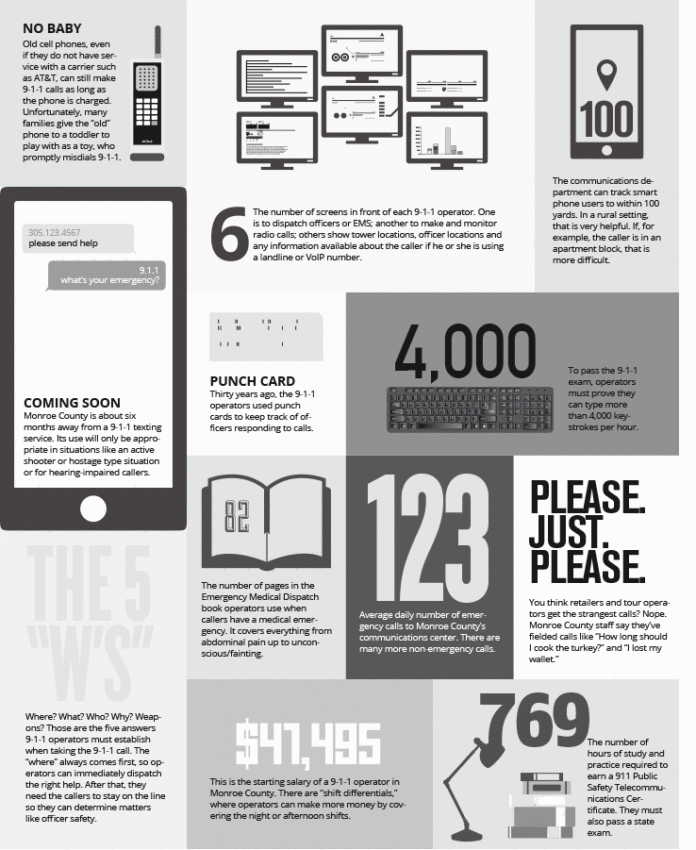This week, the nation is recognizing Public Safety Telecommunications Week, honoring those otherwise known as 9-1-1 operators.
“Our communications officers are a crucial part in our efforts to keep this community safe,” said Sheriff Rick Ramsay. “They talk with people in crisis on a regular basis; they keep track of our deputies and detectives and make sure they are safe; and they do it all so well we sometimes take them for granted. This week is a time for us all to remember how hard they work, and how much they do.”
In the islands, this is a function of the Monroe County Sheriff’s Office, but it’s important to note that they work well and often with all the other agencies, from Key West Police Department to Fish and Wildlife – and their counterparts on the mainland, too.
“Depending on the tower it ‘pings’ off, we sometimes get calls from the Everglades,” said MCSO Lt. Charlene Sprinkle, who oversees the division. “Then we transfer the call to the appropriate number.”
It is a very complicated job, and incredibly stressful. The communications officers have six monitors in front of them and the computer mouse is flitting between screens almost faster than the human eye can track.
The newbie on the 17-person telecommunications team already has two years under her belt. Two years.
“The most important takeaway is that these calls can be life and death. There’s nothing more important than that,” said Salisha LaPompe.
Terri Devooght has been on the job for 28 years. She remembers when telecommunicators kept track of officers and calls with a punch card system. She said that over the years, the nature of the calls has changed too.
“More violent domestic situations, major crashes. We get a lot of those,” Devooght said.
Every call gets answered — more than 44,000 emergency calls in any given year but also non-emergency calls between officers or agencies to verify bits of information. The operators also check to see if persons encountered by law enforcement officials are wanted in this county, or anywhere else in the United States or Canada. It also dispatches all the calls for EMS and fire rescue in Monroe County. The telecommunicators also “flight follow” every single Trauma Star flight of critically injured or ill patients to the mainland.
“They track the fuel levels, the estimated time of arrival, destination, crew and even patient status,” Sprinkle said.
The communications division is “customer oriented,” said Sprinkle, adding she follows a policy set by then-Sheriff Rick Roth. “If they call you and want to know why the grass is growing up and not down, you send a deputy.”
Many times, their job is something akin to a bloodhound. For example, the first notice of a migrant landing in the Lower Keys was a 9-1-1 call. The caller kept repeating “Cuba” over and over again and the signal was garbled. Using the tools available, the communications division was able to send the right people to the approximate right area.
“We were able to get a GPS location off the call,” said LaPompe.
It takes months and months of work to become a certified 9-1-1 Public Safety Officer. There are currently a few positions open. For more information, email csprinkle@keysso.net.
6
The number of screens in front of each 9-1-1 operator. One is to dispatch officers or EMS; another to make and monitor radio calls; others show tower locations, officer locations and any information available about the caller if he or she is using a landline or VoIP number.
PUNCH CARD
Thirty years ago, the 9-1-1 operators used punch cards to keep track of officers responding to calls.
100
The communications department can track smart phone users to within 100 yards. In a rural setting, that is very helpful. If, for example, the caller is in an apartment block, that is more difficult.
4,000
To pass the 9-1-1 exam, operators must prove they can type more than 4,000 keystrokes per hour.
No Baby
Old cell phones, even if they do not have service with a carrier such as AT&T, can still make 9-1-1 calls as long as the phone is charged. Unfortunately, many families give the “old” phone to a toddler to play with as a toy, who promptly misdials 9-1-1.
Coming Soon
Monroe County is about six months away from a 9-1-1 texting service. Its use will only be appropriate in situations like an active shooter or hostage type situation or for hearing-impaired callers.
The 5 “W’s”
Where? What? Who? Why? Weapons? Those are the five answers 9-1-1 operators must establish when taking the 9-1-1 call. The “where” always comes first, so operators can immediately dispatch the right help. After that, they need the callers to stay on the line so they can determine matters like officer safety.
Please. Just. Please.
You think retailers and tour operators get the strangest calls? Nope. Monroe County staff say they’ve fielded calls like “How long should I cook the turkey?” and “I lost my wallet.”
$41,495
This is the starting salary of a 9-1-1 operator in Monroe County. There are “shift differentials,” where operators can make more money by covering the night or afternoon shifts.
82
The number of pages in the Emergency Medical Dispatch book operators use when callers have a medical emergency. It covers everything from abdominal pain up to unconscious/fainting.
123
Average daily number of emergency calls to Monroe County’s communications center. There are many more non-emergency calls.
769
The number of hours of study and practice required to earn a 911 Public Safety Telecommunications Certificate. They must also pass a state exam.



























